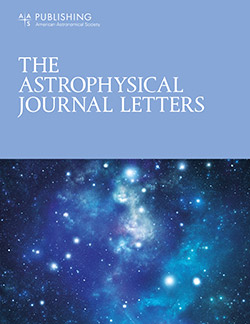CEERS MIRI Imaging: Data Reduction and Quality Assessment
IF 8.8
1区 物理与天体物理
Q1 ASTRONOMY & ASTROPHYSICS
引用次数: 1
Abstract
Abstract The Cosmic Evolution Early Release Science Survey (CEERS), targeting the Extended Groth Strip extragalactic field, is one of the James Webb Space Telescope Director’s Discretionary Early Release Science programs. To date, all observations have been executed and include NIRCam/MIRI imaging and NIRSpec/NIRCam spectroscopic exposures. Here we discuss the MIRI imaging, which includes eight pointings, four of which provide deep imaging with the bluer bands (F560W and F770W) and four of which provide contiguous wavelength coverage in F1000W, F1280W, F1500W, and F1800W, where two of these also include coverage in F770W and F2100W. We present a summary of the data, data quality, and data reduction. The data reduction is based on the jwst calibration pipeline combined with custom modifications and additional steps designed to enhance the output quality, including improvements in astrometry and the removal of detector artifacts. We estimate the image depth of the reduced mosaics and show that these generally agree with expectations from the Exposure Time Calculator. We compare the MIRI F560W and F770W flux densities for bright sources to measurements from Spitzer/IRAC Ch3 (5.8 μ m) and Ch4 (8.0 μ m), and we find that they agree with systematic differences of <0.1 mag. For the redder MIRI bands, we assess their quality by studying the spectral energy distributions (SEDs) of Galactic stars. The SEDs are consistent with the expected Rayleigh–Jeans law with a deviation of ∼0.03 mag, indicating that the MIRI colors are reliable. We also discuss all publicly released data products (images and source catalogs), which are available on the CEERS website ( https://ceers.github.io/ ).CEERS MIRI成像:数据减少和质量评估
宇宙演化早期释放科学调查(CEERS)是詹姆斯·韦伯太空望远镜主任自主决定的早期释放科学项目之一,以扩展生长带星系外场为目标。迄今为止,已经执行了所有观测,包括NIRCam/MIRI成像和NIRSpec/NIRCam光谱曝光。这里我们讨论MIRI成像,它包括8个点,其中4个点提供较蓝波段的深度成像(F560W和F770W),其中4个点提供F1000W、F1280W、F1500W和F1800W的连续波长覆盖,其中2个点还包括F770W和F2100W的覆盖。我们对数据、数据质量和数据缩减进行了总结。数据缩减是基于jwst校准管道,结合定制修改和旨在提高输出质量的额外步骤,包括改进天体测量和去除探测器伪像。我们估计了减少的马赛克的图像深度,并表明这些通常符合曝光时间计算器的期望。我们将明亮光源的MIRI F560W和F770W通量密度与Spitzer/IRAC Ch3 (5.8 μ m)和Ch4 (8.0 μ m)的测量结果进行了比较,发现它们符合<0.1等的系统差异。对于较红的MIRI波段,我们通过研究银河系恒星的光谱能量分布(SEDs)来评估它们的质量。SEDs与预期的瑞利-金斯定律一致,偏差为~ 0.03等,表明MIRI颜色是可靠的。我们还讨论了所有公开发布的数据产品(图像和源目录),这些产品可在CEERS网站(https://ceers.github.io/)上获得。
本文章由计算机程序翻译,如有差异,请以英文原文为准。
求助全文
约1分钟内获得全文
求助全文
来源期刊

Astrophysical Journal Letters
ASTRONOMY & ASTROPHYSICS-
CiteScore
14.10
自引率
6.30%
发文量
513
审稿时长
2-3 weeks
期刊介绍:
The Astrophysical Journal Letters (ApJL) is widely regarded as the foremost journal for swiftly disseminating groundbreaking astronomical research. It focuses on concise reports that highlight pivotal advancements in the field of astrophysics. By prioritizing timeliness and the generation of immediate interest among researchers, ApJL showcases articles featuring novel discoveries and critical findings that have a profound effect on the scientific community. Moreover, ApJL ensures that published articles are comprehensive in their scope, presenting context that can be readily comprehensible to scientists who may not possess expertise in the specific disciplines covered.
 求助内容:
求助内容: 应助结果提醒方式:
应助结果提醒方式:


